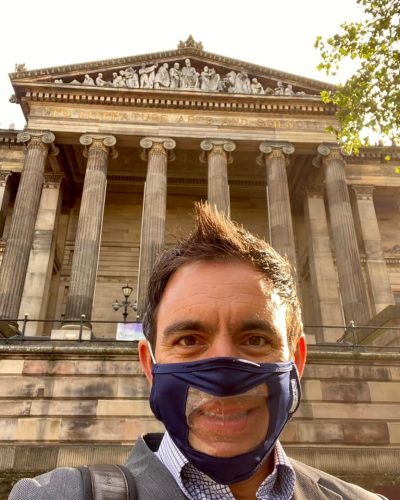
Direct Access founder Steven Mifsud MBE was interviewed for the Harris Museum’s ‘Harris Your Place’ profile series, highlighting key people in the site’s ongoing refurbishment. An ambitious undertaking, it is set to be the first blended museum, art gallery, and library in the UK.
Conducting the interview with Steven is Eleanor Ghebache, Marketing Officer at the Harris.
Tell us a little about your inclusion in The Harris Your Place project?
Sure thing! Direct Access’ story with The Harris actually started as far back as 2019. Initially, our accessibility consultancy had signed a contract with Lancashire County Council and Preston City Council, who jointly run the museum, to develop and prepare for their major heritage lottery application and the overall refurbishment for The Harris Your Place project. Our primary goal was to lead the development and implementation of the Museum’s future accessibility measures and inclusivity, which was identified as a clear factor in the project’s mission to bring communities together and provide a voice to local people.
Since the scope of the project was very ambitious and meant transforming The Harris into the first blended museum, art gallery, and library in the UK, we jumped at the opportunity to showcase the variety of ways that ensuring accessibility for all can make a difference to local communities. We knew that with our expertise and guidance, we could assist the team at the Harris to drastically increase not only the frequency of visitors, but the variety.
By this point, our team had worked with several other legacy museum clients and witnessed the growth that came with refurbishments, so we knew we had what it took to help the Harris achieve its goals with this project.
I was brought on the project as part of the wider Direct Access team to deliver consultation, access audits, and design review services to improve access for disabled people. This meant reviewing the building itself, the interpretation, and exhibits at The Harris – which we were tasked with via a procurement route. But we’ve been absolutely honoured to work with some incredible teams throughout the project, including those at The Harris and of course the architects at Buttress.
Initially, an accessibility audit of the current site was undertaken that included a review of the first stage proposals. A bespoke grading system was used that identified quick wins of minimal cost that could be implemented along with a schedule of works to be included in Heritage Lottery bids.
As with all of Direct Access’ consultancy work, our approach was informed by the fact that our accessibility auditing team consists largely of disabled people with lived experience of the challenges faced by people like ourselves in built environments. Having that kind of understanding massively informs our approach to refurbishment, as rather than just applying what accessibility guidance recommends, we were able to go further to identify ways that the Harris could embed a truly comfortable and pleasant visitor experience, while also identifying measures that would create further opportunities for employment of disabled people at the museum.
I would say that the structure and listed status of the building presented challenges for ourselves, the architects, and the wider design team to come up with creative solutions to improve access and preserve the building features, layout and design. Personally, I think the result will be great and will really open up The Harris to provide a more welcoming and inclusive environment for everyone, including disabled people. It’s going to be incredible.
As part of our work, Direct Access worked with The Harris team and Preston City Council to engage the local community and involve disabled people as part of the project. The disability community of Preston provided us with amazing feedback that we were then able to feed into the design process.
Direct Access does our absolute best to offer opportunities for apprenticeships. We’ve actually had several cases in the past few years of bringing young people on and training them to deliver accessibility audits on a local and international level since our work on the Harris.
Well, as I was born as a profoundly Deaf individual, I effectively grew up in a world that did not cater to my personal requirements, and so I was often frustrated with the inaccessibility of places that many people take for granted, such as schools, public transport, housing, retail parks and museums. This fact ultimately gave me a drive to get involved in the business of accessibility.
When it comes to auditing and consultancy, I first started as an in-house access consultant for Chester City Council, where I advised on the accessibility of the Council’s locally managed properties. I then had a brief stint working for another accessibility firm before I registered Direct Access as a business in 2004.
Twenty years after the fact, my team’s collective determination to create access for everyone remains the same, and it was clear to us that there was a desire for this value to be embedded in the Harris Your Place project. So it’s been a true honour for us to work with the Museum towards that goal.
If we were to take The Harris out of our possible answers, I’d have to say Preston Station where we have been the Access Consultants since 2017. As part of our work with Avanti West Coast, a Changing Places was installed at that station on Platform 3. Obviously, the more accessible the local transport infrastructure is, the more opportunities there are for people to visit the iconic Harris. Preston Station is also the first place many people see once they arrive in Preston!